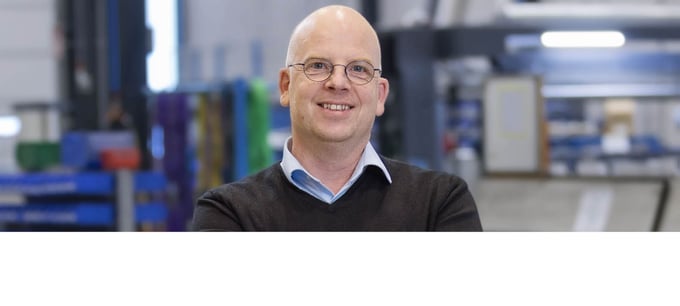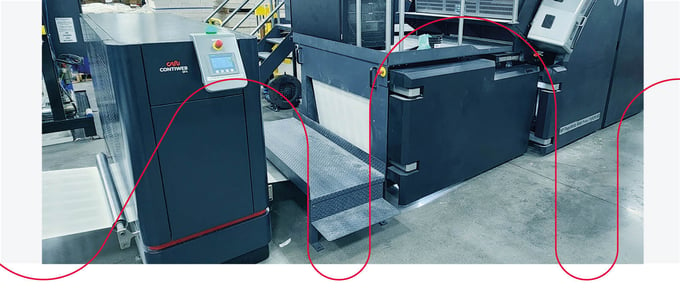Value Stream Mapping in Inkjet. Finding the Easy Win.
Across the world there are more than 2,500 high-speed, single-pass web-fed inkjet press lines in operation. The equipment manufacturers have succeeded in providing very high reliability systems, with print quality steadily improving which allows the technology to be used in catalogues, magazines, marketing collateral and general commercial printing. The economics make inkjet attractive for short to medium runs, with the inherent flexibility and variable content capability valued by print companies and their customers.
Inkjet press suppliers now offer systems that deliver the equivalent of good lithographic print on offset papers, although many benefit from priming to optimise the quality. Web-fed inkjet, linked with finishing systems, is a proven solution, directly competing with offset litho as well as toner printing. Due to its speed and economic model, anything the operator can do to boost the continuity and efficiency of production is advantageous to make web-fed inkjet even more competitive.
Value Stream Mapping
There are lots of proven techniques to improve productivity, following LEAN manufacturing methods to minimise downtime and wastage and optimise the overall operating efficiency of the equipment. These are holistic approaches from enquiry to delivery, using workflow automation to minimise touchpoints in prepress, materials handling, printing and finishing.
A useful tool is value activity, or value stream mapping. This approach identifies every activity carried out over the course of a shift or a day for a machine, or a personnel member. Then determines if the activity is directly adding value to customers. If the activity does add value then continue to do it (preferably better). If the activity is not valuable then stop doing it if and when possible.
For continuous inkjet printing there will be a press start-up routine, then make-ready and printing, with further job change overs and a close down at the end of the day (or week if running a 24 hour shift pattern). There may be necessary cleaning and maintenance routines carried out while jobs are not running to make sure the quality is fine, perhaps a calibration test of a new substrate is needed and maybe some proofing. All these activities, while negative for immediate productivity, contribute positively to customer requirements. There are other non-productive events. The press may be delayed if there are issues with job files. Ideally, this will be addressed with prepress workflow automation to ensure jobs are verified and appropriately queued or concatenated. If there is no work the press won’t run of course, but another cause of downtime is reel changes.
Depending on the reel diameter and caliper of paper there may be between six and twenty kilometers of paper on a reel (3.7 to 12.4 miles.) At a print speed of 150m (492 feet) per minute it will take between just under 40 minutes to 2 hours and 10 minutes to print the reel until a new one is needed. The time to change a reel can vary hugely, from an optimal 5 minutes to over twenty if the operator is doing other tasks. At a nominal 10 minute changeover, with a roll taking an hour to print, this non-productive time in an eight hour shift amounts to 68.5 minutes, 14.3% of the available time. Often the printed reel will be changed at the same time elongating the downtime, but this is a much faster process. In the worst case, almost a third of the potential productive time may be lost. In the best case (running slowly) between 5-10% of time may be lost for reel changes. If there are substrate changes between jobs there will be additional downtime, with partial reels increasing the frequency of changeovers.
Print operators will often carry out printhead cleaning and other maintenance during the reel change to make the most of the lost time, but this may reduce the sense of urgency around achieving the best production up-time. The economics of print production do not change for digital production. Print companies only make money when they print sellable copies. This does not happen during non-productive time. Provided there is enough work, eliminating lost time for reel changes is an easy way of saving a lot of non-productive time and increasing capacity without adding additional shifts or overtime. If a press has an hourly rate of $200, adding automatic reel changing can easily release $55,000-100,000 of additional machine time for a single shift operation annually. That number could be doubled or tripled for multi-shift patterns.
When paper changes are not managed optimally, through batching, concatenated jobs and effective splicing there can also be a high degree of paper waste. This is increasingly a challenge where paper shortages require increased width or grade changes as printers accept substitute stocks based on availability. One potential automation solution that helps optimize press up-time, minimize labor and reduce paper waste is a non-stop winding solution. Installing an automatic reel splicer provides a short payback period as well as providing sustainability advantages, and the equipment can be switched onto any new press in the future.
Easy win
Increasing market pressures in commercial printing are forcing every player do more with less. Those working with offset web presses should already be familiar with the benefits of non-stop winding and automated splicing solutions. Inkjet is now a more attractive option for sheet and web offset printers who need to offer greater agility to help their customers, while controlling cost and reducing their environmental footprint. Experienced inkjet printers in other segments are increasing their output by moving into commercial print where there are more substrates used, often for short runs. Even with ideal workflows to batch jobs there may be a greater number of reel changes needed, so reducing the wasted time is proving to be valuable for all print providers. Investing in automatic reel changing equipment may be an easy win.
To find out if a non-stop winding solution makes sense for your operation, check out this winding savings calculator.




